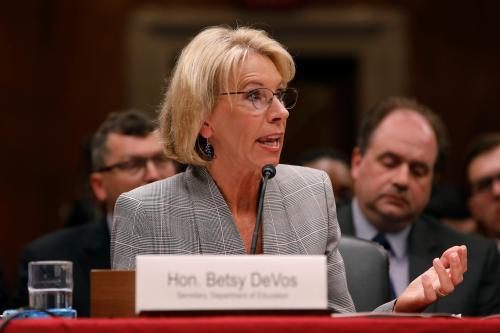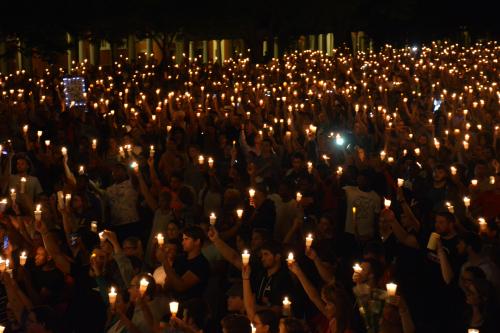This story was originally published within The Hechinger Report, a nonprofit, independent news organization focused on inequality and innovation in education.
Children have to be taught how to hate each other
I see you. You are not alone. You, who sent me that desperate email after seeing your colleagues transpose the words slave and immigrant, mislabel black boys as special-needs students and not intervene (or even assist) when school resource officers (otherwise known as police officers) to publicly humiliate, abuse and arrest black children. You wrote me about racist mascots, fight songs and rituals. You want to teach your fellow teachers the error of their ways, but you’ve seen the consequences of speaking out: termination, transfer and blackballing. And so you write to me instead:
“Since last school year, I have been advocating on behalf of school children of a top ten, predominantly white, rich public high school. The staff, system, and society is full of bigots & bigotry. And the few who aren’t are afraid of speaking and/or addressing acts/activities against the minority/minorities. My questions to you are who and where should I go to get the help and justice for them?”
Emails like this in my inbox from outraged teachers, administrators, and school employees just like you tell me that you need an outlet to air your grievances and a strategy to expose the injustices in your workplace. For you, I offer advice and support.
Remember what you’re up against. You’re not just fighting individual teachers or lone principals; you’re protesting a system of oppression. Schools have always been cogs in the machine of institutionalized racism. The only way to throw a wrench in the works—permanently—is through a collective, anti-racist political campaign that addresses the whole structure of racism. That reads big, but it starts with joining local anti-racist organizations. Online support groups like #educolor and #hiphoped can provide advice from teachers and educators across the country. You can’t go at it alone, chiefly because those who endorse racism have backup.
Since 2000, at least 36 school districts have seceded from larger ones, which helps explain why the percentage of all schools with racial or socio-economic isolation grew from 9 percent to 16 percent from 2001 to 2014.
Communities, ones organized by race, socioeconomic class and geography, use schools to cover blatant housing discrimination, school financing bias, and white supremacy. Since 2000, at least 36 school districts have seceded from larger ones, according to EdBuild, a nonprofit that works on creating fair school financing structures. This kind of behavior helps explain why the U.S. Government Accountability Office found the percentage of all schools with racial or socio-economic isolation grew from 9 percent to 16 percent from 2001 to 2014. Schools aren’t unbiased, apolitical institutions, or separate from the communities they serve. These segregated schools uphold the values, racial hierarchies and cultural norms of the people who created them.
Consequently, anti-racist teachers like you and me must organize like-minded educators to form our own community. National labor unions can play an incredibly important role here. Because local unions can reflect the racial attitudes of the confined geographic area, leadership and involvement from the national-level group is almost always necessary. Also, work with civil rights groups so they can speak for you. The NAACP Legal Defense Fund, Southern Poverty Law Center, National Urban League and its local affiliates, as well as the American Civil Liberties Union, come to mind. I want to be able to include the U.S. Department of Education’s Office for Civil Rights in this list, but Education Secretary Betsy DeVos announced earlier this summer they were scaling back civil rights investigations.
It’s simply harder for individuals to seek redress against what is really a coalition between powerful neighborhood groups, civic leaders and school system heads. I won’t lie to you—the pushback will be fierce. Hate has been normalized to such an extent that many consider it a legacy worth preserving.

In the aftermath of the white supremacist rally in Charlottesville, Va., President Barack Obama tweeted a Nelson Mandela quote: “No one is born hating another person because of the color of his skin or his background or his religion…” The tweet became the most liked in the history of Twitter.
White supremacist beliefs aren’t passed on like genetic disorders; you have to be taught to believe something so irrational. Families, churches, communities, and the schools within them work in concert to indoctrinate children to burn crosses, hail Nazism, and join organizations like the Klu Klux Klan and its modern-day descendants. Because people often reserve overtly racist behaviors for special events, we have to look for other signs. Some clues to racist schools include harsh, uneven discipline, or lessons that aren’t rigorous or relevant to black students. These issues are concrete goals for a political campaign. Another sign is political antagonism toward black school boards. Don’t be fooled. Breaking up black school boards has more to do with disrupting black power than implementing a proven strategy to improve academic achievement.
Genes may not pass on white supremacy, but education policies certainly do. In 2011, South Carolina established academic standards for what students should learn in social studies classes, including “the economic necessity of slave labor.”
That’s horrific enough. But racism is imparted not just by what a state demands its students to learn; it’s also about what they don’t require—learning the true history of our country.
In a brilliant GQ profile of Dylann Roof, the white supremacist who brutally killed nine parishioners of Mother Emanuel AME Church in Charleston, S.C. in 2015, reporter Rachel Kaadzi Ghansah wrote, “What Roof didn’t understand when he walked into that church was the genius of black America’s survival and the nature of our overcoming.” We plant the seeds of racism when all children don’t learn black history, which is a question of policy about state academic standards.
Policy is a culpable accomplice to encouraging racism—from big federal and state policies that incarcerate black men at five times the rate of white ones, to school-level unequal policing of black girls’ dress codes. Fighting racism requires us to address our racist colleagues and neighbors as well as their values, as manifested in policy.
Students may be the most powerful weapons to help us change policy. Remember, students are feeling the same racism you are—in many cases, more. Students have walked out on state standardized tests in protest. Last year, the Louisiana Youth Justice Coalition convened young people and advocates from around the state on the steps of the Louisiana State Capitol to call for juvenile justice reform. To change racist policies, follow the lead of student groups such as Rethink, a nonprofit dedicated to youth organizing.
You are right in taking a stand against bigotry in schools, though you should expect retribution. But you can’t make ending racism a personal crusade. As the African proverb says, “If you want to go fast, go alone. If you want to go far, go together.”
– Andre Perry
Your brother in fighting racism in schools
The Brookings Institution is committed to quality, independence, and impact.
We are supported by a diverse array of funders. In line with our values and policies, each Brookings publication represents the sole views of its author(s).







Commentary
Open letter to teachers who feel trapped in racist schools
August 30, 2017